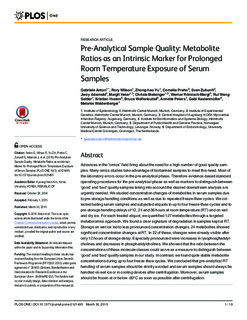| dc.contributor.author | Anton, Gabriele | |
| dc.contributor.author | Wilson, Rory | |
| dc.contributor.author | Yu, Zhong-Hao | |
| dc.contributor.author | Prehn, Cornelia | |
| dc.contributor.author | Zukunft, Sven | |
| dc.contributor.author | Adamski, Jerzy | |
| dc.contributor.author | Heier, Margit | |
| dc.contributor.author | Meisinger, Christa | |
| dc.contributor.author | Römisch-Margl, Werner | |
| dc.contributor.author | Wang-Sattler, Rui | |
| dc.contributor.author | Hveem, Kristian | |
| dc.contributor.author | Wolfenbuttel, Bruce | |
| dc.contributor.author | Peters, Annette | |
| dc.contributor.author | Kastenmuller, Gabi | |
| dc.contributor.author | Waldenberger, Melanie | |
| dc.date.accessioned | 2015-11-25T11:20:17Z | |
| dc.date.accessioned | 2016-01-07T12:48:56Z | |
| dc.date.available | 2015-11-25T11:20:17Z | |
| dc.date.available | 2016-01-07T12:48:56Z | |
| dc.date.issued | 2015 | |
| dc.identifier.citation | PLoS ONE 2015, 10(3) | nb_NO |
| dc.identifier.issn | 1932-6203 | |
| dc.identifier.uri | http://hdl.handle.net/11250/2372840 | |
| dc.description.abstract | Advances in the “omics” field bring about the need for a high number of good quality samples. Many omics studies take advantage of biobanked samples to meet this need. Most of the laboratory errors occur in the pre-analytical phase. Therefore evidence-based standard operating procedures for the pre-analytical phase as well as markers to distinguish between ‘good’ and ‘bad’ quality samples taking into account the desired downstream analysis are urgently needed. We studied concentration changes of metabolites in serum samples due to pre-storage handling conditions as well as due to repeated freeze-thaw cycles. We collected fasting serum samples and subjected aliquots to up to four freeze-thaw cycles and to pre-storage handling delays of 12, 24 and 36 hours at room temperature (RT) and on wet and dry ice. For each treated aliquot, we quantified 127 metabolites through a targeted metabolomics approach. We found a clear signature of degradation in samples kept at RT. Storage on wet ice led to less pronounced concentration changes. 24 metabolites showed significant concentration changes at RT. In 22 of these, changes were already visible after only 12 hours of storage delay. Especially pronounced were increases in lysophosphatidylcholines and decreases in phosphatidylcholines. We showed that the ratio between the concentrations of these molecule classes could serve as a measure to distinguish between ‘good’ and ‘bad’ quality samples in our study. In contrast, we found quite stable metabolite concentrations during up to four freeze-thaw cycles. We concluded that pre-analytical RT handling of serum samples should be strictly avoided and serum samples should always be handled on wet ice or in cooling devices after centrifugation. Moreover, serum samples should be frozen at or below -80°C as soon as possible after centrifugation. | nb_NO |
| dc.language.iso | eng | nb_NO |
| dc.publisher | Public Library of Science | nb_NO |
| dc.title | Pre-analytical sample quality: Metabolite ratios as an intrinsic marker for prolonged room temperature exposure of serum samples | nb_NO |
| dc.type | Journal article | nb_NO |
| dc.date.updated | 2015-11-25T11:20:17Z | |
| dc.source.volume | 10 | nb_NO |
| dc.source.journal | PLoS ONE | nb_NO |
| dc.source.issue | 3 | nb_NO |
| dc.identifier.doi | 10.1371/journal.pone.0121495 | |
| dc.identifier.cristin | 1252270 | |
| dc.description.localcode | © 2015 Anton et al. This is an open access article distributed under the terms of the Creative Commons Attribution License, which permits unrestricted use, distribution, and reproduction in any medium, provided the original author and source are credited. | nb_NO |
